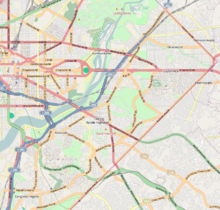Anacostia Museum
 |
|
|
Location within Washington, D.C.
|
|
| Established | 1967 |
|---|---|
| Location | Washington, D.C. |
| Coordinates | 38°51′25″N 76°58′37″W / 38.856854°N 76.976888°W |
| Type | History museum |
| Visitors | 38,963 (2008) |
| Director | Camille Akeju |
| Public transit access |
|
| Website | Official website |
The Anacostia Community Museum (known colloquially as the ACM) is a community museum in the Anacostia neighborhood of Washington, D.C. in the United States. It is one of twenty museums under the umbrella of the Smithsonian Institution and was the first federally funded community museum in the United States. The museum, founded in 1967, was created with the intention to bring aspects of the Smithsonian museums, located on the National Mall, to the Anacostia neighborhood, with the hope that community members from the neighborhood would visit the main Smithsonian museums. It became federally funded in 1970 and focuses on the community in and around Anacostia in its exhibitions. This museum also houses a library.
The Anacostia Community Museum was originally described as "an experimental store-front museum" by the Smithsonian Institution in 1966. Smithsonian Secretary S. Dillon Ripley intended for the museum to serve as an outreach opportunity to bring more African Americans to the National Mall to visit Smithsonian museums. The idea, which rose from a Smithsonian-hosted conference in 1966, came into reality in March 1967, when the Smithsonian acquired the Carver Theater in the Anacostia neighborhood. The Smithsonian sought community support, and a council of local Anacostia residents came together to advise on the project. John Kinard was appointed director of the museum in June 1967. A pastor and activist during the Civil Rights Movement, Kinard was heavily involved in the Anacostia neighborhood, and he made sure that the young people of the neighborhood were involved in the creation of the museum. Every week, the museum's Neighborhood Advisory Committee of community members would meet to help plan the programming and exhibitions. Staff and community members worked side by side to change the building from a defunct movie theater into an exhibition space. The community also assisted in choosing what objects would be displayed.
...
Wikipedia

